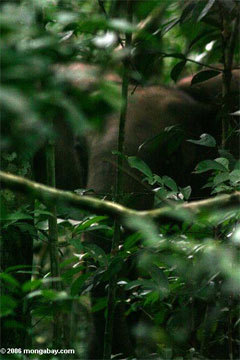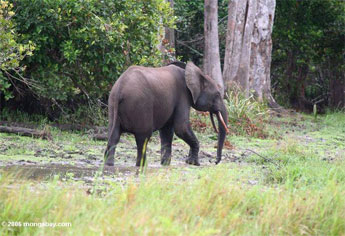When elephants attack. Surviving an elephant charge in the Congo rainforest of Gabon
When elephants attack. Surviving an elephant charge in the Congo rainforest of Gabon
Rhett A. Butler, mongabay.com
June 26, 2006
What not to do when an adult elephant charges
The leaves shake with a low rumbling sound.
I look over at Patrick.
“Stomach.The elephant is hungry.”
Patrick is a little off on his assessment of the sound emanating from the elephant. It’s not the elephant’s stomach but a low-frequency, partially infrasonic elephant call used in warning or to call to offspring. Confusion notwithstanding, we crouch to watch the adult forest elephant grab trunkfuls of leaves from the surrounding vegetation as the growling continues.
We are in the rainforest of Loango National Park in the Central African country of Gabon.The five of us—local guides, Patrick and Ghislan; Flip, a veteran safari guide from Zimbabwe; Francesco, a fellow traveler from Italy; and myself—have quietly approached a family of forest elephants: a bull, a cow, and her calf.
Slightly smaller than their more familiar relative, the savanna elephant, forest elephants are generally shy animals confined to the dark recesses of tropical forests in West and Central Africa. Here in Loango, where forest is interspersed with savanna, these pachyderms sometimes appear in plain sight as they move across grassy zones and swampy meadows. However, at the first hint of danger, they move back into the protective cover of the forest where they blend surprisingly well into the shadows.
Our local Gabonese guides tracked these elephants using the tell-tale signs left by these giant beasts. Elephant damage can be significant. Hiking through the forest, one comes into areas that look as if they have been hit by a tornado—fallen branches, canopy trees reduced to splinters, bark torn from trunks by ivory tusks, and stumps worn smooth by sandpaper-like skin. Elephants will topple entire trees just to reach the most succulent leaves.
Beyond the forest damage, there are more obvious signs including prodigious amounts of droppings and giant footprints which can be read by trackers like a book. Everything from an elephant’s age to health, sex, and pace can be determined by examining these clues.
This path has led us to these elephants. Barely detectable visually through the thick forest vegetation, their presence is betrayed by rumbling sounds and the crash of vegetation being torn from its roots and the canopy. We inch closer, deliberately measuring each step. The wind is in our favor—with their poor eyesight elephants are highly dependent on their sense of smell for detecting predators and onlookers.
Suddenly the cow appears to be aware of our presence. She shakes her head furiously and takes a few menacing steps in our direction.
I look to Cliff, whose scars bear testament to a lifetime to personal encounters with wild animals. His expression is not one of comfort.
“Move back! Move back now!” He exclaims in a shouted whisper as he backtracks carefully but quickly.
Fully aware of our presence now, the elephant charges. The ground trembles.
Hearts racing, we are now sprinting through the forest dodging vegetation as the elephant plows right through it. The problem with being chased by an elephant, aside from their obvious size advantage, is they can run faster than you. Not helping the situation, two of us are obvious targets, wearing light-colored T-shirts—my dark blue shirt was a magnet for tse-tse flies.
Looking over my shoulder I see Patrick and Francesco have stopped and are holding their ground. The charging behemoth has abandoned the chase. A half-hearted charge, thankfully. Still Flip, who on foot has witnessed countless charges from elephants, lions, buffalo, and other African wildlife, says we should give the elephants a wide berth—they are obviously perturbed by our closeness in a forest where they were poached only a generation ago for their ivory, which is finer and more valuable than that of their savanna cousins.
“We need to stay clear of the elephants,” Flip warns the local guides. “Approaching them again would be a mistake—that’s how you get flattened.” (Flip is training local Gabonese, many of them reformed poachers—how to be ecotourist guides.)
“We need to be careful. The elephants are not feeding. When they are feeding they are relaxed. They are still agitated.”
Then Cliff launches into an account of the trampling of a fellow guide experienced first hand. Later I ask Cliff what we would have done had the elephant been more determined.
Flip explains that in a true charge, there are a few options. Climbing a sizeable tree—one the elephant cannot knock over—is a possibility for the nimble. So is throwing a decoy, like a hat or shirt, which the elephant can “kill” while you run to safety. Local Gabonese hunters have their own technique for escaping elephants—hiding between the stilt roots of swamp trees. Used to support trees in sandy, nutrient poor soils, these roots act as a protective barrier against elephants. Standing still can also help but is tough to recommend in the face of several tons of mammal bearing down on you.
While wild elephants can be dangerous animals under the right circumstances, other creatures are responsible for more deaths in Africa. Topping the list is the hippo, whose penchant for capsizing canoes that come too close results in the dumping of passengers who often can’t swim. Buffalo, crocodiles, and lions are directly responsible for more deaths and injuries.
The disturbed elephant has now gone back to feeding. Then quickly and quietly, the elephants disappear. It is remarkable that such a large animal can evaporate so silently into the forest.
 Charging elephant in Gabon. Photographing a charging elephant while fleeing through the forest is not as easy as it sounds. Photo by Rhett A. Butler. MORE PICTURES FROM GABON |
Later we encounter the three elephants on the open savanna. Able to size us up in the clear seems to reduce their anxiety and they go about their business, mostly ignoring us.
Earlier in the year elephants can be commonly seen patrolling the fine white sand beaches of the park. Other safari animals visit the beach as well, and Loango has become world-famous for its “surfing” hippos; National Geographic photographers have documented hippos in the Atlantic Ocean surf.
Attractions such as these are bringing increasing numbers of eco-minded tourists to Gabon. In a country highly dependent on oil, reserves of which are fast-dwindling, ecotourism is seen as an important source of employment and revenue for the people of Gabon. Operation Loango, an integrated conservation and development program launched following the completion of biologist Mike Fay’s 455-day trek across the Congo rainforest, is playing a key role in the effort. The operation consists of a series of lodges located in and around the national park as well as an ape conservation project that conducts research on the ecological needs of gorillas and apes found within the boundaries of protected area.
Loango is seen as a model, and if it is successful, conservation groups hope to replicate the Loango experience in the country’s more remote parks, 12 more of which have recently been established by the government in an effort to set aside 10 percent of its land mass for protection. Loango’s success will equate to ever greater preservation of Gabon’s wildlife. While the elephants won’t know the difference, they will be better off because of our visit.
Pictures from Gabon
Elephant Listening Project at Cornell University
